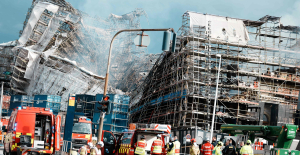When the British Royal Navy was at the height of its power, it could afford to lay down entire classes of ships that proved to be defective designs. The most famous example are the battle cruisers that John Fisher, as First Sea Lord, had built from 1906. They were designed to combine the battleship's firepower with the cruiser's speed, but at the expense of their armor. Of the 15 capital ships of this type, the Navy would lose seven in combat.
Even longer was the list of disasters suffered by the giant K-class submarines laid down by the Royal Navy from 1915. As with the battlecruisers, it was a highly innovative concept that also aimed to fill a gap in the screen around the battleships. While the battlecruisers were used for rapid reconnaissance, the K-cruisers were intended as escorts.
With them, the Admiralty drew the consequences of the sinking of the battleship HMS "Formidable", which was sunk in the English Channel by the German U24 on January 1, 1915. Even before the outbreak of war in 1914, there had been considerations about building submarines that would be able to follow the battleships over water. These plans have now been resumed at high pressure by the Navy's design department.
The biggest problem proved to be the requirement that the boats should reach a surface speed of more than 20 knots. Since this could not be achieved with contemporary diesel engines, the idea of installing two oil-fired steam turbines, each with an output of 5250 hp, which should be supported by a diesel-powered auxiliary engine (800 hp), came up. There were also four electric motors, each with 350 hp, for underwater operation.
Test drives showed that it could be driven at up to 24 knots. However, this drove the consumption up exorbitantly. While the range was 23,000 kilometers at a cruising speed of ten knots, it dropped to 1,500 kilometers at top speed. The tanks required for this, a crew of around 60 and the heavy armament – eight torpedo tubes, two to three guns and a depth charge launcher – drove the size of the boats into unimagined dimensions.
With 1980 tons afloat and 2566 tons submerged, they clearly surpassed the British high seas boats (900/1150 tons) and even the large German U-cruisers (1500/1900 tons). Which is reflected in the cost. £300,000 was due per unit, and 18 were ordered immediately.
The problems of the giants were obvious. "It took an average of five minutes to shut down the boilers, evacuate the boiler room and close the fans before the boat could dive," writes British military historian Robert Hutchinson. When the sea was high, water repeatedly entered through chimneys and extinguished the fire in the boilers, rendering the boats unmanoeuvrable (the auxiliary engines had since been dispensed with). There were always problems with the numerous hatches and valves. "The boats had too many holes," commented one crew member.
To make matters worse, the first five specimens had a flat, level bow that made them top-heavy, allowing them to dive of their own accord. This design flaw almost led Britain into a royal crisis. The Navy officer Prince Albert of York, the second eldest son of George V, King of the United Kingdom of Great Britain and Northern Ireland, had also announced that he was to take part in the test drive that K3 was to undertake in December 1916.
Suddenly, the 100-meter-long boat started an uncontrollable diving maneuver and struck the bottom 45 meters deep with its bow, while the stern stuck out of the waves with the spinning propellers, Hutchinson writes. K3 was only able to free himself after 20 minutes. What catastrophe the later King George VI. and father of Elizabeth II had escaped was shown in January 1917 when K13 remained under water during a diving test. After two days, 36 seamen were rescued from holes cut in the hull, but for 31 any help came too late.
From then on, the K-boats lived up to their nickname "Calamity Class" because they were not decimated by opponents, but by Navy units. In early 1917 an explosion occurred on K2 during the first dive test, in 1924 it was due to collide with K12. This also happened to K1, which was rammed by K4 in November 1917. There were no survivors on K5, which sank off Torquay in January 1921 while trying to dive.
The sad climax of the series of catastrophes came on January 31, 1918, which went down in the annals of the Royal Navy as the "Battle of May Island". Codenamed Operation ECI, nine K-Boats in two flotillas were mobilized to accompany the Grand Fleet on a night march from their base at Scapa Flow. A group was confused by several minesweepers off the island of May in the Firth of Forth. K14 was rammed by K22. Shortly thereafter, the disabled K22 was torn open by the battlecruiser HMS "Inflexible".
The lead cruiser of the second flotilla then drove over K17. In the chaos, K4 was literally cut through by K6 and then the bow was run over by K7. After 75 minutes, two K-boats had sunk, three badly damaged and 105 sailors had lost their lives.
Of the planned second series of slightly modified and enlarged K-boats only K26 was completed, all other orders were cancelled. But the giants continued to swam through the imaginations of British naval leaders. Three boats were converted to U-monitors, one later even to a U-plane carrier. However, they did not get rid of their unlucky streak.
You can also find "World History" on Facebook. We are happy about a like.

 Sydney: Assyrian bishop stabbed, conservative TikToker outspoken on Islam
Sydney: Assyrian bishop stabbed, conservative TikToker outspoken on Islam Torrential rains in Dubai: “The event is so intense that we cannot find analogues in our databases”
Torrential rains in Dubai: “The event is so intense that we cannot find analogues in our databases” Rishi Sunak wants a tobacco-free UK
Rishi Sunak wants a tobacco-free UK In Africa, the number of millionaires will boom over the next ten years
In Africa, the number of millionaires will boom over the next ten years WHO concerned about spread of H5N1 avian flu to new species, including humans
WHO concerned about spread of H5N1 avian flu to new species, including humans New generation mosquito nets prove much more effective against malaria
New generation mosquito nets prove much more effective against malaria Covid-19: everything you need to know about the new vaccination campaign which is starting
Covid-19: everything you need to know about the new vaccination campaign which is starting The best laptops of the moment boast artificial intelligence
The best laptops of the moment boast artificial intelligence Bitcoin halving: what will the planned reduction in emissions from the queen of cryptos change?
Bitcoin halving: what will the planned reduction in emissions from the queen of cryptos change? The Flink home shopping delivery platform will be liquidated in France
The Flink home shopping delivery platform will be liquidated in France Bercy threatens to veto the sale of Biogaran (Servier) to an Indian industrialist
Bercy threatens to veto the sale of Biogaran (Servier) to an Indian industrialist Switch or signaling breakdown, operating incident or catenaries... Do you speak the language of RATP and SNCF?
Switch or signaling breakdown, operating incident or catenaries... Do you speak the language of RATP and SNCF? The main facade of the old Copenhagen Stock Exchange collapsed, two days after the fire started
The main facade of the old Copenhagen Stock Exchange collapsed, two days after the fire started Alain Delon decorated by Ukraine for his support in the conflict against Russia
Alain Delon decorated by Ukraine for his support in the conflict against Russia Who’s Who launches the first edition of its literary prize
Who’s Who launches the first edition of its literary prize Sylvain Amic appointed to the Musée d’Orsay to replace Christophe Leribault
Sylvain Amic appointed to the Musée d’Orsay to replace Christophe Leribault Skoda Kodiaq 2024: a 'beast' plug-in hybrid SUV
Skoda Kodiaq 2024: a 'beast' plug-in hybrid SUV Tesla launches a new Model Y with 600 km of autonomy at a "more accessible price"
Tesla launches a new Model Y with 600 km of autonomy at a "more accessible price" The 10 best-selling cars in March 2024 in Spain: sales fall due to Easter
The 10 best-selling cars in March 2024 in Spain: sales fall due to Easter A private jet company buys more than 100 flying cars
A private jet company buys more than 100 flying cars This is how housing prices have changed in Spain in the last decade
This is how housing prices have changed in Spain in the last decade The home mortgage firm drops 10% in January and interest soars to 3.46%
The home mortgage firm drops 10% in January and interest soars to 3.46% The jewel of the Rocío de Nagüeles urbanization: a dream villa in Marbella
The jewel of the Rocío de Nagüeles urbanization: a dream villa in Marbella Rental prices grow by 7.3% in February: where does it go up and where does it go down?
Rental prices grow by 7.3% in February: where does it go up and where does it go down? With the promise of a “real burst of authority”, Gabriel Attal provokes the ire of the opposition
With the promise of a “real burst of authority”, Gabriel Attal provokes the ire of the opposition Europeans: the schedule of debates to follow between now and June 9
Europeans: the schedule of debates to follow between now and June 9 Europeans: “In France, there is a left and there is a right,” assures Bellamy
Europeans: “In France, there is a left and there is a right,” assures Bellamy During the night of the economy, the right points out the budgetary flaws of the macronie
During the night of the economy, the right points out the budgetary flaws of the macronie These French cities that will boycott the World Cup in Qatar
These French cities that will boycott the World Cup in Qatar Europa Conference League: the semi-final flies to Lille, which loses to the wire against Aston Villa
Europa Conference League: the semi-final flies to Lille, which loses to the wire against Aston Villa Lille-Aston Villa: Cash disgusts Lille, the arbitration too... The tops and the flops
Lille-Aston Villa: Cash disgusts Lille, the arbitration too... The tops and the flops Handball: Les Bleues in the same group as Spain at Euro 2024
Handball: Les Bleues in the same group as Spain at Euro 2024 Europa Conference League: for Létang, Martinez “does not have the attitude of a high-level athlete”
Europa Conference League: for Létang, Martinez “does not have the attitude of a high-level athlete”


















